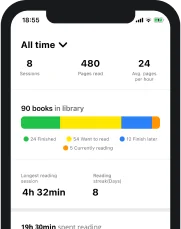There are several reading strategies out there, each meant to help us achieve different things through our reading sessions. Intensive and extensive reading are techniques that have a different impact on the outcome of each of our reading sessions, but they are both equally important.
Here at Basmo, we are dedicated to providing you with the necessary knowledge to help you earn every skill that is a necessary part of every accomplished reader’s toolbox. In order for you to be able to accomplish every single one of your reading goals, you will need an extended set of skills and good knowledge of different reading strategies and techniques. We’re here to help, so here’s what you should know about intensive and extensive reading.
What is intensive reading?
Intensive reading is defined as the process of reading with a clear short-term goal in short and intense bursts of effort. The intensive reading meaning becomes more obvious when comparing it to extensive reading, but for now, let’s have a closer look at the process of reading intensively.
This reading strategy requires an in-depth examination of the text at hand. It involves a clear intent and a dedicated effort to understand the content and its meaning down to the last, seemingly insignificant detail. Another very important characteristic of an intensive reading session refers to its duration.
Intensive reading is usually done in short bursts, focusing on a small text or a short portion of larger reading material. The process of intensive reading consists of closely analyzing the text, deconstructing sentences and paragraphs and breaking them down to the last word, and carefully analyzing the meaning of each word and how the text is constructed.
The goal of intensive reading is to gain a deep and detailed understanding of a small portion of a text by analyzing it grammatically and syntactically while also paying close attention to its meaning and significance.
What is extensive reading?
Extensive reading is a casual process. This reading technique is probably the most commonly used by casual readers. It has mainly entertaining purposes and focuses more on the experience than the analysis.
The extensive reading meaning is easier understood when comparing it with intensive reading. While intensive reading is done in short bursts on small portions of content, extensive reading, as the name suggests, is usually done over prolonged sessions.
The reading material is less important in this strategy, and the final purpose of the reading session is not to gain a complete understanding of the matter at hand or an in-depth analysis of the text. Through extensive reading, you are expected to gain a general understanding of the material, deduce the meaning of unfamiliar words from context, and enjoy yourself while doing it.
To put things in some kind of perspective, intensive reading is the most appropriate technique when it comes to studying or reading non-fiction, while extensive reading is the strategy of choice when it comes to reading fiction or reading for pleasure instead of learning.
What is the difference between intensive and extensive reading?
There are many differences between intensive and extensive reading. While some of these differences refer to the ultimate goal of the reading sessions, others have more to do with the nature of the process, the material selection, the nature of the reading session, and the additional techniques involved.
The most important thing for you to remember is that applying the wrong reading strategy to different materials will have a negative impact on the outcome of your reading session and can seriously impact your progress toward your ultimate goals. Keeping that in mind, here are some of the most important differences between these two strategies.
1. Intensive and extensive reading have completely different purposes
While intensive reading is done with a clear intent to completely comprehend a text, extensive hearing has a more supplementary nature. The goal of an intensive reading session is to gain an in-depth understanding of a topic or a particular text, while extensive reading is an appropriate technique to use when the goal is to read for pleasure or to gather more superficial amounts of information on a particular topic.
2. They are done at different speeds
As you may know, your reading speed has a direct impact on how your reading session progresses and what its outcome is. That being said, you should know that intensive reading, despite what its name might suggest, requires you to actually slow down. It is done in short bursts, on small portions of text, but your reading speed needs to be low enough to allow you to carefully analyze every possible aspect of the reading material, including the particular words used and the deeper meaning of the content.
On the other hand, extensive reading can be done at your regular speed since it requires less attention to detail and allows you to focus more on the experience than the details in the text.
3. The reading material matters too
The two reading strategies should be used accordingly, depending on the reading material at hand. While the ultimate goal of the reading session is the most important factor to consider when determining which technique is going to help you achieve what you are planning to achieve, you should adapt your strategy to the text at hand.
For example, the books you generally read for pleasure, like non-fiction novels, will most likely be the ideal material for extensive reading. Intensive reading is more appropriate for non-fiction, textbooks, and texts you are looking to analyze in-depth in order to extract the most value from your session.
4. They impact your vocabulary differently
Whether you have a dictionary on hand during your reading session should also be a determining factor in whether you are reading intensively or extensively.
In intensive reading, you are supposed to pay attention to every single word and make sure you have a good understanding of its meaning. For that purpose, a dictionary or at least access to a dictionary is mandatory. Every unfamiliar word needs to be looked up and understood completely.
On the other hand, a dictionary is not required in extensive reading sessions. Since your main focus is not to understand the text down to the last detail but to gain a general understanding of its meaning and the concepts presented, it is perfectly acceptable for you to simply deduce the meaning of unfamiliar words from context.
An important thing to keep in mind is that neither of the techniques is wrong, meaning that there is no guarantee that you will learn and remember the meaning of a new word if you look it up in the dictionary. At the same time, there is no rule saying that deducing the meaning of a word from context means that you won’t add that particular word to your vocabulary.
5. They improve different skills
When it comes to reading, we are in a constant state of development. Our abilities get constantly better or worse depending on how often and how much we read and how focused we are on our reading performance. It is important to know that intensive and extensive reading have completely different effects on your reading abilities.
Intensive reading is known to develop your ability to think critically and improve your analytical skills. It has a positive effect on vocabulary development and grammatical knowledge and understanding.
On the other hand, extensive reading is a great tool for improving fluency and reading speed. It also impacts your vocabulary in a positive manner, and, since extensive reading is generally done with fiction books, it can enhance your imagination, improve your emotional intelligence, and boost your empathy.
6. They differ in follow-up activities
While intensive reading is usually required to be a part of a longer, more complex process, extensive reading is a more independent process.
Intensive reading generally involves answering some questions about the text, re-reading certain parts of the content to ensure that you understand it, reviewing notes, and even learning about or exploring the topic further. Intensive reading can be followed by discussions about the text, additional assignments, or a more intense introspective stage.
Extensive reading is an independent activity. It does not require any preparation or follow-up activities.
Is intensive reading a good reading habit?
Yes, intensive reading is, without a doubt, a positive addition to your life as a reader. While it does come with some drawbacks, there are many reasons to consider intensive reading a very good reading habit.
What are the benefits of intensive reading?
- Improves comprehension ability
- Enhances writing skills
- Boosts vocabulary
- Increases general knowledge
- Enhances memory and concentration levels
- Improves critical thinking
What are the disadvantages of intensive reading?
- It puts strain on your brain
- It’s time consuming
- It can be rather boring at times
- It can sometimes keep you from seeing the bigger picture
Pros and cons of extensive reading
Knowing when to choose extensive reading as a strategy can help you achieve important goals. It is also important to always keep in mind what extensive reading is good for and what it is not so appropriate for. Here are the most relevant pros and cons of extensive reading so you always know what you should expect when applying this reading strategy.
What are the benefits of extensive reading?
- It is a pleasurable activity
- Improves literal fluency
- Boost cultural understanding
- It helps improve your background knowledge on certain topics
- It can be relaxing
- It improves your vocabulary
- It can help you learn to enjoy reading
What are the disadvantages of extensive reading?
- It has a limited effect on improving critical skills
- It doesn’t help vocabulary development as much as intensive reading
- It can be distracting and tiring
- It is time consuming
- It limits your ability to focus
- It doesn’t promote an attention to detail
How to use Basmo for intensive and extensive reading
While these two strategies both come with advantages and drawbacks, knowing when to choose the right one for the task at hand can make things easier and more effective. And speaking of making things easier and the process more efficient, you should know that Basmo, our reading tracking app, is a game-changer when it comes to reading, especially when using particular reading strategies that are meant to boost your performance and general experience. Here’s why.
Basmo allows you to create and manage reading lists efficiently. As I mentioned before, intensive and extensive reading should be used for completely different tasks and with different reading material. For that purpose, it would be ideal to keep your reading lists separate, divided by the strategy that is most appropriate for each title.
With Basmo, you can easily create and manage separate reading lists for the books you should apply intensive reading and those that are fine with an extensive reading strategy.
You can take notes as you read. Any reading session can benefit from diligent note-taking. That is especially true if we’re applying certain reading strategies to our sessions. With that in mind, we made sure that our app comes with a well-performing note-taking feature that allows you to simply start typing while a reading session is ongoing. The notes can be formatted however you see fit and you can easily access them later within the books they are related to.
Basmo promotes healthy reading habits. Setting goals, creating a reading schedule, and managing your reading performance are very important things to include into your reading habits. They can give you purpose, improve your general experience and performance, and add structure and order to the way you read. While these features are helpful in any scenario, they are particularly important for you when you want to use intensive and extensive reading strategies, because they make the process smoother and more meaningful.
Final thoughts
Both intensive and extensive reading are very effective strategies. Learning when and how to apply them to your reading depending on your goals and the reading material at hand can completely change the outcome of your reading sessions. Use Basmo and take full advantage of the benefits each reading strategy has to offer.
Image by storyset on Freepik







